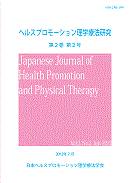Volume 2, Issue 2
Displaying 1-7 of 7 articles from this issue
- |<
- <
- 1
- >
- >|
ORIGINAL ARTICLES
-
2012 Volume 2 Issue 2 Pages 47-52
Published: 2012
Released on J-STAGE: November 07, 2012
Download PDF (40K) -
2012 Volume 2 Issue 2 Pages 53-57
Published: 2012
Released on J-STAGE: November 20, 2012
Download PDF (30K) -
2012 Volume 2 Issue 2 Pages 59-63
Published: 2012
Released on J-STAGE: November 20, 2012
Download PDF (71K)
SHORT REPORT
-
2012 Volume 2 Issue 2 Pages 65-68
Published: 2012
Released on J-STAGE: November 27, 2012
Download PDF (34K) -
2012 Volume 2 Issue 2 Pages 69-72
Published: 2012
Released on J-STAGE: November 27, 2012
Download PDF (28K) -
2012 Volume 2 Issue 2 Pages 73-75
Published: 2012
Released on J-STAGE: November 27, 2012
Download PDF (23K) -
2012 Volume 2 Issue 2 Pages 77-80
Published: 2012
Released on J-STAGE: November 27, 2012
Download PDF (33K)
- |<
- <
- 1
- >
- >|
